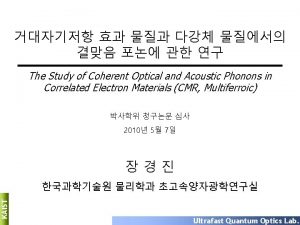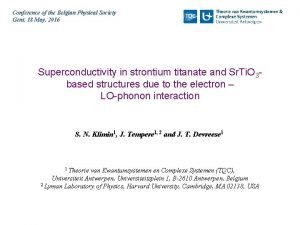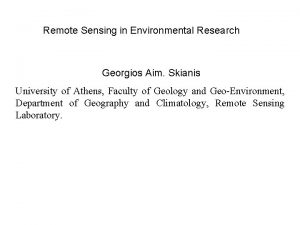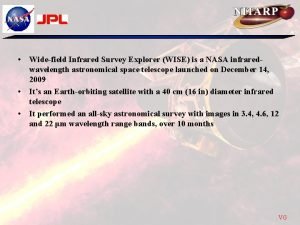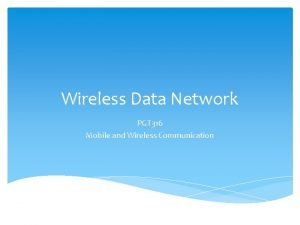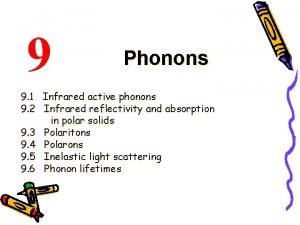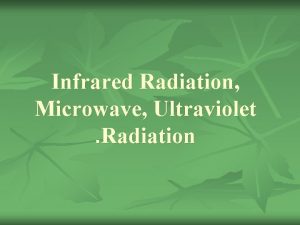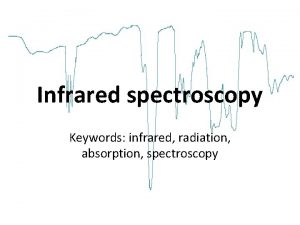10 Phonons 10 1 Infrared active phonons The








- Slides: 8

10 Phonons

10. 1 Infrared active phonons The resonant frequencies of the phonons occur in the infrared spectral region, and the modes that interact directly with light are called infrared active (IR active). The phonon modes of a crystal are subdivided into two general categories: • acoustic or optical; • transverse or longitudinal. It is the “optical” rather than the acoustic modes that are directly IR active. These optically active phonons are able to absorb light at their resonant frequency. Conservation laws require that the photon and the phonon must have the same energy and momentum. Dispersion curves for the acoustic and optical phonon branches in a typical crystal with a lattice constant of a. The dispersion of the photon modes is shown by the dotted line. At small wave vectors the slope of the acoustic branch is equal to vs, the velocity of sound, while the optical modes are essentially dispersionless near q=1. At the intersection , which corresponds to the resonance, the frequency is equal to that of the optical mode at q=0. Photons couple to TO phonons through the driving force exerted on the atoms by the AC electric field of the light wave. This can only happen if the atoms are charged, or the crystal must have some ionic character. The crystals with ionicity contain the ionic crystals and the crystals with partly covalent bonds (polar bonds)

10. 2 Infrared reflectivity and absorption in polar solids 10. 2. 1 The classical oscillator model where By putting x = x+ -- x- for the relative displacement of positive and negative ions with their unit cell, the equation of motion in the simpler form: Interaction of a TO phonon mode propagating in the z direction with an electromagnetric wave of the same wave vector. The black circles represent positive ions, while the grey circles represent the negative ions. The solid line represents the spatial dependence of the electric field of the electromagnetric wave. When the wave vectors and frequencies match, the strong interaction at resonance between a TO phonon mode and an infrared light occurs at q 0 (~10 m). There will be thousands of unit cells (usually less than 10 -9 m) within one period of the wave. The equation of motion for the positive and negative displaced ions: where 2 TO for K/. represents the natural vibrational frequency of the TO mode at q = 0 in the absence of the extend light field. The equation represents the equation of motion for undamped oscillations of the lattice driven by the forces exerted by AC electric field of the light wave. In reality, a damping term to account for the finite lifetime of the phonon mode should be incorporated into the eqn by introducing a damping rate : The response of the medium to a light field of angular frequency with E (t) = E 0 e i t: where represents the non-resonant susceptibility of the medium, and N is the number of unit cells per unit volume.

10. 2. 1 The classical oscillator model In the limits of low frequency: In the limits of high frequency: Thus we can write: where 10. 2. 2 in relative sense here. The waves are transverse. If r = 0, the equation can be satisfied with waves in which that is, with longitudinal waves. The dielectric can support longitudinal electric field waves at frequencies which satisfy r( ’) = 0. The waves at = ’ correspond to LO phonon wave, namely LO, thus This is the Lyddane-Sachs-Teller (LST) relationship. The Lyddane-Sachs-Teller relationship For a lightly damped system with =0, assume r = 0 at ’: This can be solved to obtain: What does r=0 mean physically? When = 0, For r 0 and wave solutions with the form: we have The data in the table imply that the LO phonon and TO phonon modes of non-polar crystals are degenerate. There is no infrared resonance, and therefore r = . This is indeed the case for the purely covalent crystals of the group IV element namely diamond (c), silicon and germanium.

10. 2. 3 Restrahlen Set = 0, the dielectric constant has the following frequency dependence: A wave number of 1 cm-1 is equivalent to a frequency of 2. 998 1010 Hz. 1 THz = 1012 Hz. 1 ps = 10 -12 s III-V semiconductor At low frequency the dielectric constant is just equal to r. As v increases from 0, r (v) gradually increases until it diverges when the resonance at v. TO is reached. Between v. TO and v. LO , r is negative. Precisely at v = v. LO, r = 0. thereafter, r is positive, and gradually increases towards the value of . The most important optical property of a polar solid in the infrared spectral region is the reflectivity. The reflectivity is equal to 100 % in the frequency region between v. TO and v. LO. This frequency region is called the restralen band. Light cannot propagate in the restrahlen band. Infrared reflectivity of In. As and Ga. As at 4. 2 K. there is a sharp dip in the reflectivity just above the LO phonon resonance. This reduction in reflectivity from 100 % is caused by ignoring the damping term. The damping also broadens the edge so that there is only a minimum in R just above v. LO rather than a zero. The magnitude of obtained in this way are around 1011 -1012 s-1, which implies that the optical phonons have a lifetime of about 1 -10 ps.

10. 3 Inelastic light scattering can be medicated by many different types of elementary excitations in a crystal such as phonons, magnons or plasmons. Inelastic light scattering from phonons is subdivided as: • Raman scattering: scattered from optical phonons; • Brillouin scattering: scattered from acoustic phonons 10. 3. 1 General principles of inelastic light scattering Inelastic light scattering can be subdivided into two types: Stokes scattering: emitting a phonon or other excitation; Anti-Stokes scattering: absorbing a phonon. Conservation of energy: The light is shifted down in frequency – Stokes; The light is shifted up in frequency – anti-stokes. The ratio of anti-stokes to stokes scattering is given by: The probability for anti-Stokes scattering is very low at cryogenic temperatures.

The maximum phonon frequency in a typical crystal is about 1012 – 1013 Hz. This is almost two orders of magnitude smaller than the frequency of a photon in the visible spectral region. Thus the maximum frequency shift for photon will be around 1%. and The maximum possible value of q thus occurs for the back-scattering geometry: Experimental apparatus used to record Raman spectra. The maximum value of q is of order 107 m-1. This is very small compared to the size of the Brillouin zone in a typical crystal (~ 1010 m-1). Inelastic scattering is thus only able to probe small wave vector phonons. 10. 3. 2 Raman scattering is mainly used to determine the frequency of LO and TO modes near the Brillouin zone centre, and gives little information about the dispersion of the phonons (optical ponons are essentially dispersionless near q = 0). IR reflectivity and light scattering is of complementarity. The full selection rule requires the use of group theory. However, a simple rule can be given for crystals that posses inversion symmetry: • The odd parity modes are IR active; • The even parity modes are Raman active. This is called the rule of mutual exclusion. In non-centrosymmetric crystals, some modes may be simultaneously IR and Raman active. Raman spectra obtained from four III-V crystals at 300 K using a Nd: YAG laser at 1. 064 m. the spectra are plotted against the wave number shift: 1 cm-1 is equivalent to an energy shift of 0. 124 me. V. These correspond to Stokesshifted signals from the TO phonons and LO phonons. The LO mode is the one at higher frequency.

10. 3. 3 Brillouin scattering It refers to inelastic light scattering from acoustic phonons. Its main purpose is to determine the dispersion of these acoustic modes. The frequency shift of the phonon in the scattering is given by One phonon is annihilated and two new phonons are created. where s is the velocity of the acoustic waves, and is the angle through which is light is scattered. This can be used to determined the velocity of the sound waves. 10. 4 Phonon lifetimes Analysis of the experimental data on the reflectivity in the restrahlen band show that damping constant is typically in the range 1011— 10 12 s-1. Since is equal to lifetime -1, the data implies that is in the range 1 – 10 ps. The very short lifetime of the optical phonons is caused by anharmonicity in the crystal. In general, the atoms sit in a potential well of the form: Decay of an optical phonon into two acoustic phonons by a three -phonon interaction. The term in x 2 is the harmonic term. The term in x 3 and higher are the anharmonic terms. These anharmonic terms allow phonon – phonon scattering processes. For example, the term in x 3 allows interactions involving three phonons. The lifetime of the optical phonons can be deduced from Raman data in three different ways. Firstly, the spectral width of the Raman line is affected by lifetime broadening, which in frequency unit is expected to be (2 )-1; Secondly, can be measured directly by time-resolved Raman spectroscopy using short pulse lasers; thirdly, the lifetime of the optical phonons can be deduced from reflectivity measurements.
